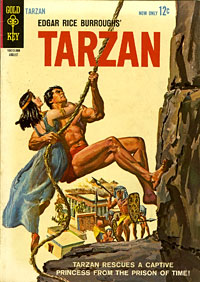 Last time I took a look at comic book versions of pulp heroes during the Golden Age of comic books. In this posting, I’ll focus on the 1960s through today.
Last time I took a look at comic book versions of pulp heroes during the Golden Age of comic books. In this posting, I’ll focus on the 1960s through today.
During this period, new comics based on the original pulp heroes appeared several times. There were also original comic book characters inspired by the pulp heroes.
In future postings, I plan to delve deeper into some of these titles, as they deserve a further look.
1960s
In 1962, the partnership between Dell and Western Publications ended, and the comics Western had been creating and publishing as Dell Comics would be published under the new Gold Key Comics imprint. Western had been publishing a Tarzan comic for a long time, and continued to do so under the Gold Key brand, soon adding a Korak comic book as well. The Tarzan comic would run adaptions by artist Russ Manning of Edgar Rice Burroughs‘ early Tarzan novels.
Due to Archie Comics connection to Belmont Books, when Belmont started new novels of The Shadow, Archie, under their new Archie Adventure imprint started a Shadow comic in 1964. This was probably the worse Shadow comic ever, as it was influenced by the “camp” phase at the time. The first issue was fairly okay, though it had a blond Lamont Cranston as The Shadow. In the second issue, he was decked out in a blue and green spandex superhero suit. But then Superman co-creator Jerry Siegel took over and really camped him up, having the now black-haired Shadow working out in a “Danger Room” to prepare for his battles with Shiwan Khan.
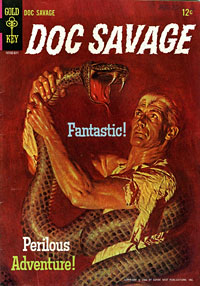 In 1966, Gold Key Comics produced two one-shot pulp hero comics. It did an adaptation of Doc Savage novel, “The Thousand Headed Man.” This was done to tie into the then-planned Doc movie from Goodson-Todman Productions that never happened. They also produced one issue of a G-8 comics, which I never understood why.
In 1966, Gold Key Comics produced two one-shot pulp hero comics. It did an adaptation of Doc Savage novel, “The Thousand Headed Man.” This was done to tie into the then-planned Doc movie from Goodson-Todman Productions that never happened. They also produced one issue of a G-8 comics, which I never understood why.
1970s
In the 1970s, both major publishers did comics with the major Street & Smith characters, most likely inspired by the successful paperback reprints.
From 1972-74, Marvel Comics did eight issues of a Doc Savage comic, with two-issue adaptations of original stories. Sadly, its image of Doc was a bit off, having him run around in a small blue vest. After canceling the comic, the 1975 movie “Doc Savage, The Man of Bronze” inspired Marvel to start a new black-and-white magazine which was much better. DC Comics has since reprinted both series in trade paperback.
In 1972, DC Comics started to expand into other genres, and obtained the rights to the Burroughs creations, bring over Tarzan and Korak from Gold Key, and adding a companion title in Weird Worlds. The Tarzan comic ran adaptions of further Tarzan novels by artist Joe Kubert, and DC also did adaptions of other Burroughs properties like John Carter (with artwork by Murphy Anderson), Pellucidar, and Carson of Venus (with artwork by Mike Kaluta).
Shortly there after, DC Comics started a Shadow series that ran 1973-75. The earlier issues, with writing by Dennis O’Neil and artwork by Kaluta, is considered by many the high watermark for Shadow comics. Kaluta has long been associated with The Shadow since then. The Avenger appeared in one issue of The Shadow, which led to his own, short-lived series in 1975. This corresponded to Warner Paperback Library’s reprinting The Avenger stories, then producing new stories by Ron Goulart (which ended in 1975).
In 1977, the Burroughs license moved to Marvel, who did Tarzan and John Carter titles. These lasted through the end of the decade.
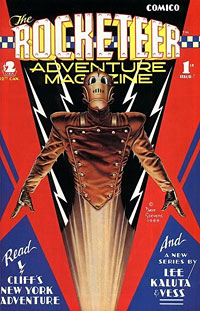 1980s
1980s
In the early 1980s, the late, great Dave Stevens created The Rocketeer, a homage to the various rocket-pack-wearing movie serial characters. His first adventure was published over 1982 through 1985, the second from 1988 through 1996. But in the first story we learn that the rocket pack was created by an unnamed Doc Savage (his aides Monk and Ham also appear unnamed as well). In the second adventure he is hired by a “Mr. Jonas,” who is really The Shadow. For obvious copyright reasons, the characters couldn’t be named, but it was clear to fans who they were.
The small press Renegade published an unusual pulp inspired series in 1985 called Wordsmith. The series focuses on a pulp fiction author, who writes several characters, including some pulp heroes. The series was reprinted in trade paperback in 1990, along with a one-shot focusing on the pulp heroes by Caliber Press, who later reprints the series in comic book form.
Another small press published the adventures of an original pulp-inspired character, the Twilight Avenger in 1986, with a further series in 1988. I think I’ve heard rumors of either a reprint of these or a new series, but not sure. I sadly don’t know much about the character.
DC Comics took another crack at The Shadow in 1986, with a mini-series by Howard Chaykin that brought the character into the modern age. Most fans either love it or hate it. This lead to a new Shadow series that culminated in The Shadow having his head cut off and put on a robot body before Conde Nast apparently pulled the plug on it.
This also lead to DC start up a new Doc Savage mini-series that also brought him into the modern age that gave him a son and grandson. With his aides too old to help him, he now worked with his grandson and several new aides. Some stories toward the end were set in the original pulp era.
After an appearance in The Shadow, The Avenger was given a new mini-series, but DC revamped his origin, claiming his ability was created by a government experiment. He and his aides became government agents, and not in a good way. It was a poor handling of the characters.
Strangely, while DC was doing their later Shadow comic, Marvel came out with an original Shadow graphic novel by O’Neil and Kaluta, but set in the original pulp era. There was talk at the time that DC would do Shadow comics set in the modern age, while Marvel would do graphic novels set in the original era, but this never happened.
1990s
After Conde Nast pulled the plug on DC’s modern Shadow comic, DC started a new one titled The Shadow Strikes set in the original pulp era. It lasted until 1992. A few issues even crossed over with Doc Savage. Some consider this Shadow comic the best, but I still feel that is the O’Neil/Kaluta work.
Doc Savage moved over to Millennium Publications from 1991-93. I thought these mini-series were the best Doc Savage comics so far. Millennium tried doing other pulp comics, but as far as I know, only produced a Captain Satan comic that wasn’t very good.
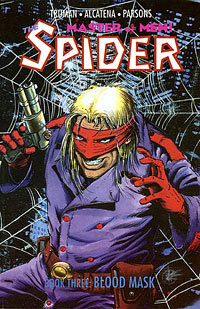 Eclipse Comics did two Spider mini-series by Timothy Truman in 1991-93. He basically set The Spider in a new universe that mixed the pulp era and the modern era, but tried to be true to the character. Both minis were very interesting.
Eclipse Comics did two Spider mini-series by Timothy Truman in 1991-93. He basically set The Spider in a new universe that mixed the pulp era and the modern era, but tried to be true to the character. Both minis were very interesting.
Argosy Communications, the owner of the copyrights to all the Popular Publications characters decided to start their own comic book imprint called Blazing Comics. It only produces a few comics: a G-8 and His Battle Aces title, another using Grun the Primeval from G-8, another using The Spider, and another using a character called “Web-Man” who supposed appeared in the back of the original Spider pulps (I had never heard of him). They also had a character named Blue Steel. This name came when the final, unpublished original Spider novel was printed in paperback, with The Spider renamed Blue Steel.
After leaving DC, The Shadow moved to Dark Horse Comics in 1993, just prior to the movie. Kaluta again was involved with this, and there were several great mini-series there. Dark Horse also did a Doc Savage comic briefly in 1995. Dark Horse’s Doc comics were the second best after Millennium, in my opinion.
Mike Mignola in 1995 created Hellboy. While maybe not a true pulp character, he was inspired by pulp horror works, such as those by H.P. Lovecraft, Clark Ashton Smith, and others, as well as various occult detectives. A whole background to the universe has slowly been revealed over the years that makes use of much of the occult (and pseudo-occult) writings of these and other authors.
Also, in 1996, Dark Horse got the license for Tarzan, and started doing various new comics and later archive reprints of classic Tarzan work (as well as John Carter).
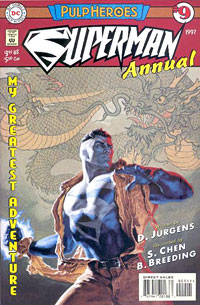 For some reason, for DC Annuals in 1997, DC went with the theme of “Pulp Heroes.” Each annual took on one of five themes: mystery/detective, science fiction, Western, or romance. Of them, the only good ones in my opinion were Superman Annual #9 by Dan Jurgens, which was done in the style of a Doc Savage adventure (there was even a sort of Doc and company cameo at the end), and Batman Annual #21 by Doug Moench, which was in done in the style of a Shadow mystery.
For some reason, for DC Annuals in 1997, DC went with the theme of “Pulp Heroes.” Each annual took on one of five themes: mystery/detective, science fiction, Western, or romance. Of them, the only good ones in my opinion were Superman Annual #9 by Dan Jurgens, which was done in the style of a Doc Savage adventure (there was even a sort of Doc and company cameo at the end), and Batman Annual #21 by Doug Moench, which was in done in the style of a Shadow mystery.
In 1998, Insight Studios put out a large trade paperback volume called Titanic Tales that was pulp inspired. It included a new Spider story.
In 1999, Mignola created Lobster Johnson in the Hellboy universe. A 1930s/’40s era pulp hero, he has since been the star of several mini-series and even an original prose novel. One story has him going up against a sort of Fu Manchu-like “Yellow Menace” character.
2000s
A new comic book imprint called “America’s Best Comics” was started by Wildstorm just prior to being bought by DC. These comics were helmed by Alan Moore, and inspired by older, classic characters. Tom Strong is obviously inspired by Doc Savage, Greyshirt by The Spirit and Jonnie Future by various pulp sf heroes, and the League of Extraordinary Gentlemen made use of pre-pulp Victorian characters, and Terra Obscura made use of the various Nedor Comics characters, including the Green Ghost.
Another comic done by Wildstorm is Planetary. This one investigated the “secret history” of the world that included characters based on pulp and proto-pulp, such as analogues to Doc Savage, Tarzan, the Lone Ranger, Green Hornet, Fu Manchu, and others.
In 2008, under the auspices of Alex Ross, Dynamite Enterainment started a new series of comics using various superheroes now in the public domain, using the title Project: Superpowers. These include the comic book version of the Green Lama.
In 2008, writer Ed Brubaker created an original pulp-inspired work: Incognito. It appeared as two mini-series in 2008 and 2010, and showed what could be done with original pulp-inspired works. A bonus of the comics was a series of excellent articles on the pulps by researcher Jess Nevins.
2010s
Probably one of the most-hyped pulp-inspired work — though a great disappointment — was DC’s First Wave effort, which ran 2010-11. Under the helm of writer Brian Azzarello, the idea was to create another universe (a sort of mix of modern age and pulp age) that included pulp heroes like Doc Savage and The Avenger, with The Spirit, and some of DC’s other characters like Rima, Batman, and the Blackhawks. However, DC decided to make changes to these characters and, worse, allowed Azzarello to basically insult all pulp fans with his remarks. A poorly done version of Doc, which was barely saved by the work of J.G. Jones toward the end, and probably the worse version of The Avenger and associates in comics was the result.
In 2011 or so, book publisher Moonstone decided to get more into pulp characters. It had been doing some excellent collections of new prose works featuring pulp and related characters The Avenger (three so far), The Spider, Zorro, and Captain Midnight.
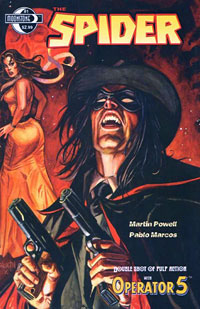 Moonstone started a series of comics with The Spider, then branched out with the “Return of the Originals,” using licensed and public domain pulp characters such as Phantom Detective, Domino Lady, The Spider, The Black Bat and more. This hasn’t been as successful as hoped, and some characters were not well used (example: The Black Bat). It remains to be seen if more come out.
Moonstone started a series of comics with The Spider, then branched out with the “Return of the Originals,” using licensed and public domain pulp characters such as Phantom Detective, Domino Lady, The Spider, The Black Bat and more. This hasn’t been as successful as hoped, and some characters were not well used (example: The Black Bat). It remains to be seen if more come out.
Also in 2011, Marvel tried to get on the bandwagon of pulp-inspired comics with Mystery Men by David Liss. This series used original pulp-inspired characters set in the early Marvel Universe: The Operative, The Aviatrix, The Doctor, The Revenant, and Achilles. No idea if more will be done.
With the John Carter movie done by Disney, which now owns Marvel, it appears that official John Carter comics will be coming from Marvel. This didn’t stop Dynamite Entertainment from doing its own John Carter (and spin off) comics under the title of Warlord of Mars since 2010, using the earlier John Carter novels that are in the public domain. Around the same time they started to do a Tarzan comic under the title Lord of the Jungle.
Then in 2012, Dynamite Entertainment got the rights to both The Shadow and The Spider (though Moonstone is still doing Spider comics). Dynamite decided to put out a crossover series called Masks that used these and several public domain characters like The Black Bat, Zorro, Miss Fury, Black Terror, Green Hornet, and Green Lama (the comic book version). It later launched a Black Bat title, along with a Miss Fury title.
For several years, comic book artist Francesco Francavilla has been running a blog called Pulp Sunday. There he showcases his pulp-inspired works, and hints at original works as well. Finally, in 2013 we got his Black Beetle at Dark Horse in a mini-series. Hopefully this will be just the start.
As a sort of followup to Incognito, in 2012 Ed Brubaker started Fatale at Image Comics. This series took its inspiration from hard-boiled detectives and Lovecraftian horror.
So this gives a good overview of pulp related comics of the last few decades. Several of them will be the subjects of more in depth postings in the future.

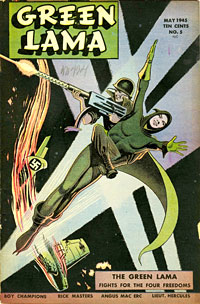
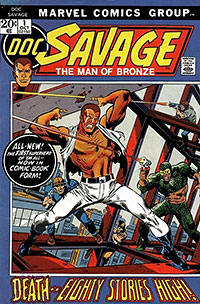
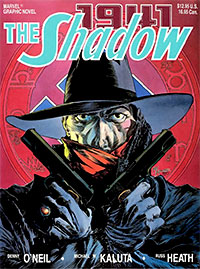
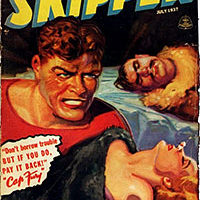
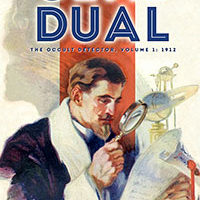
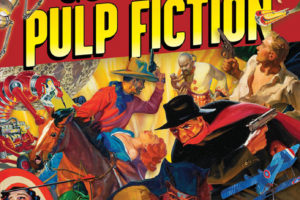
Your comments